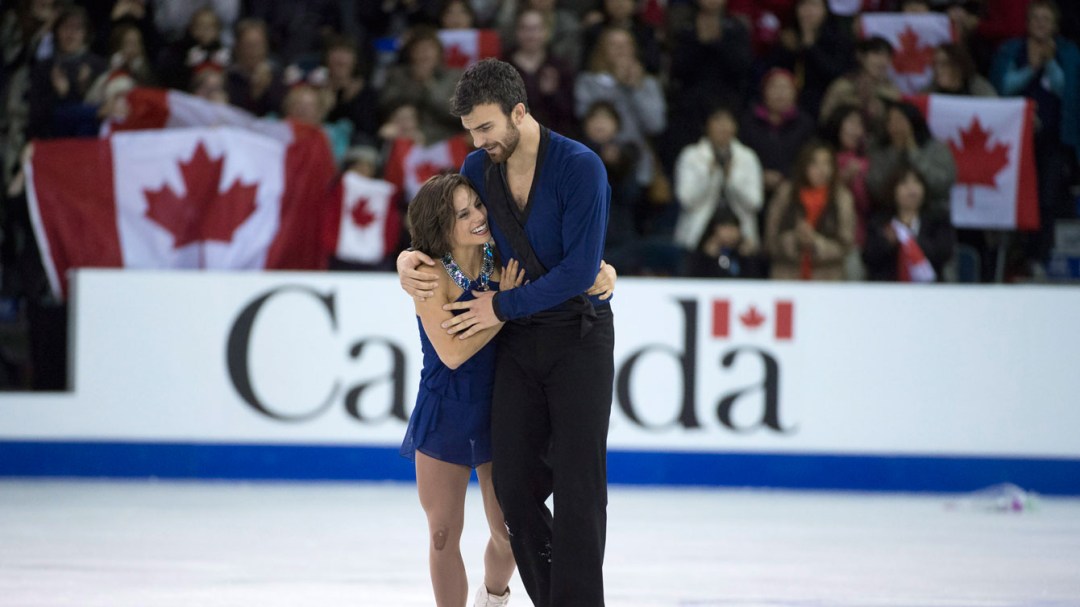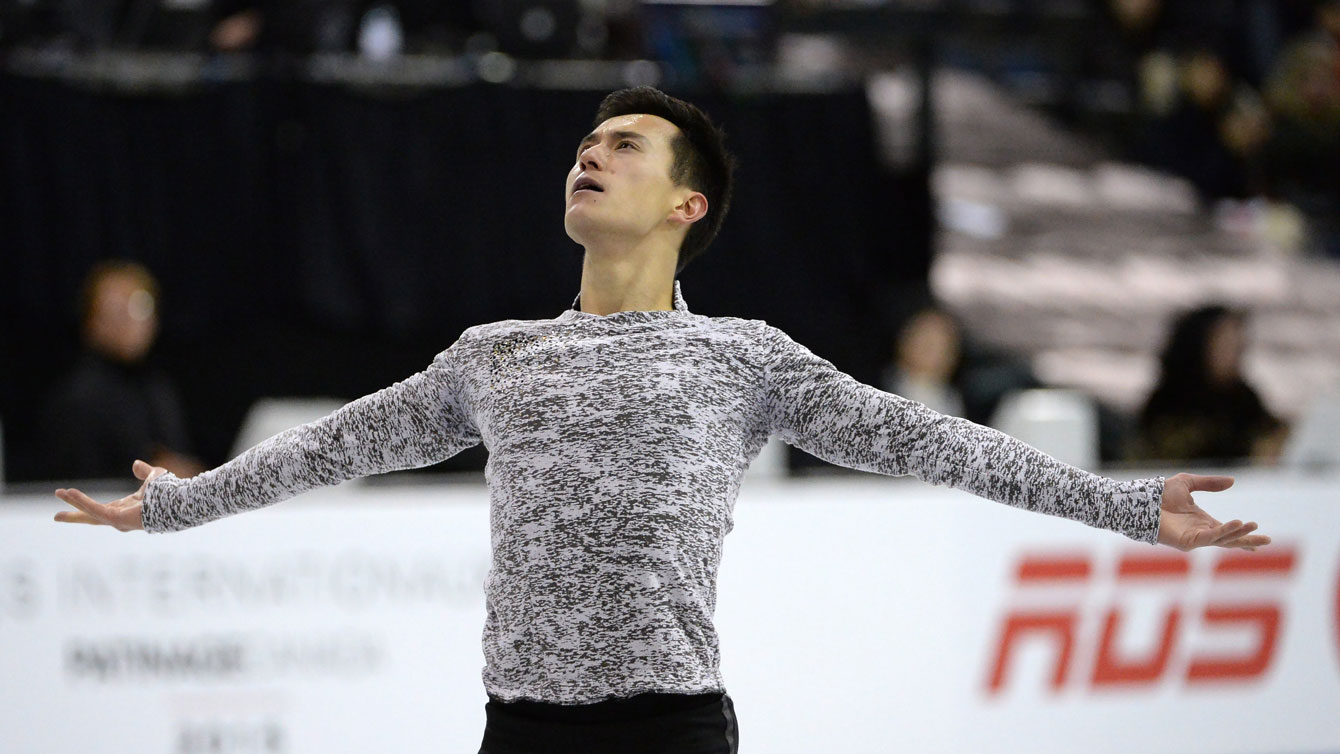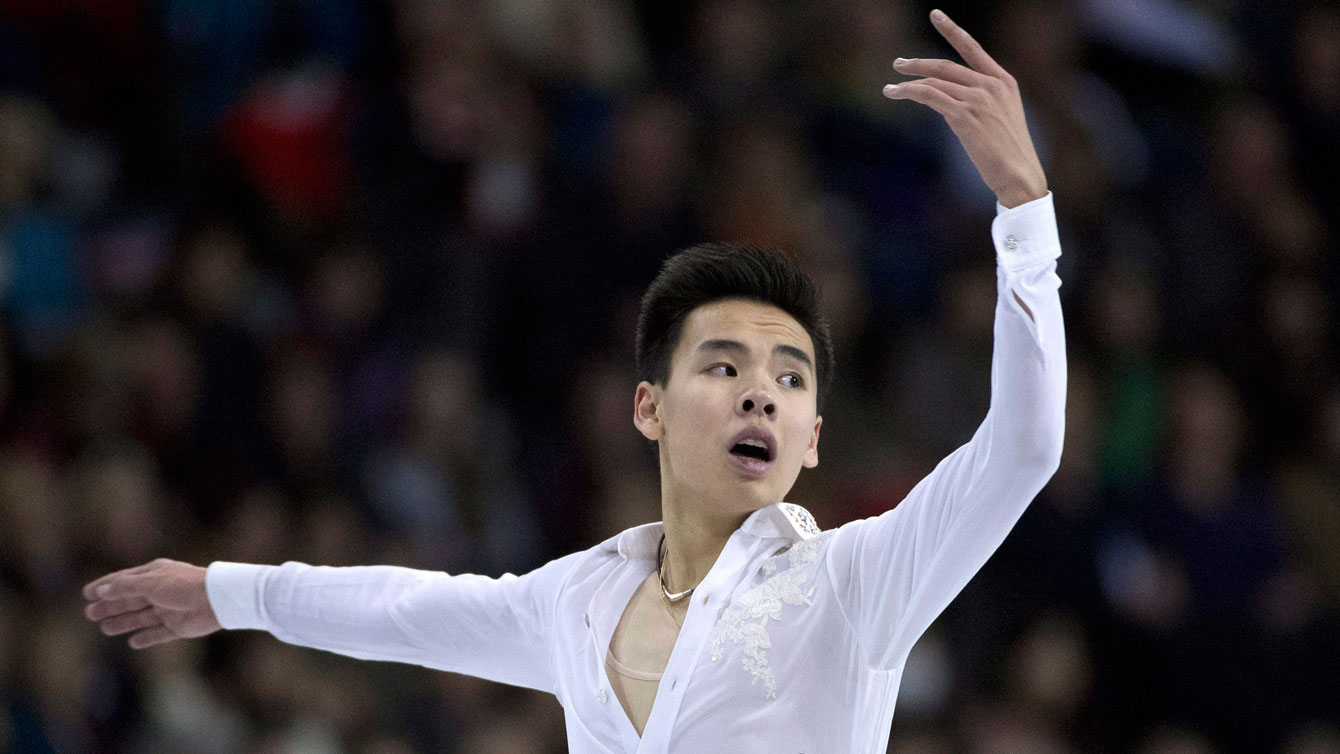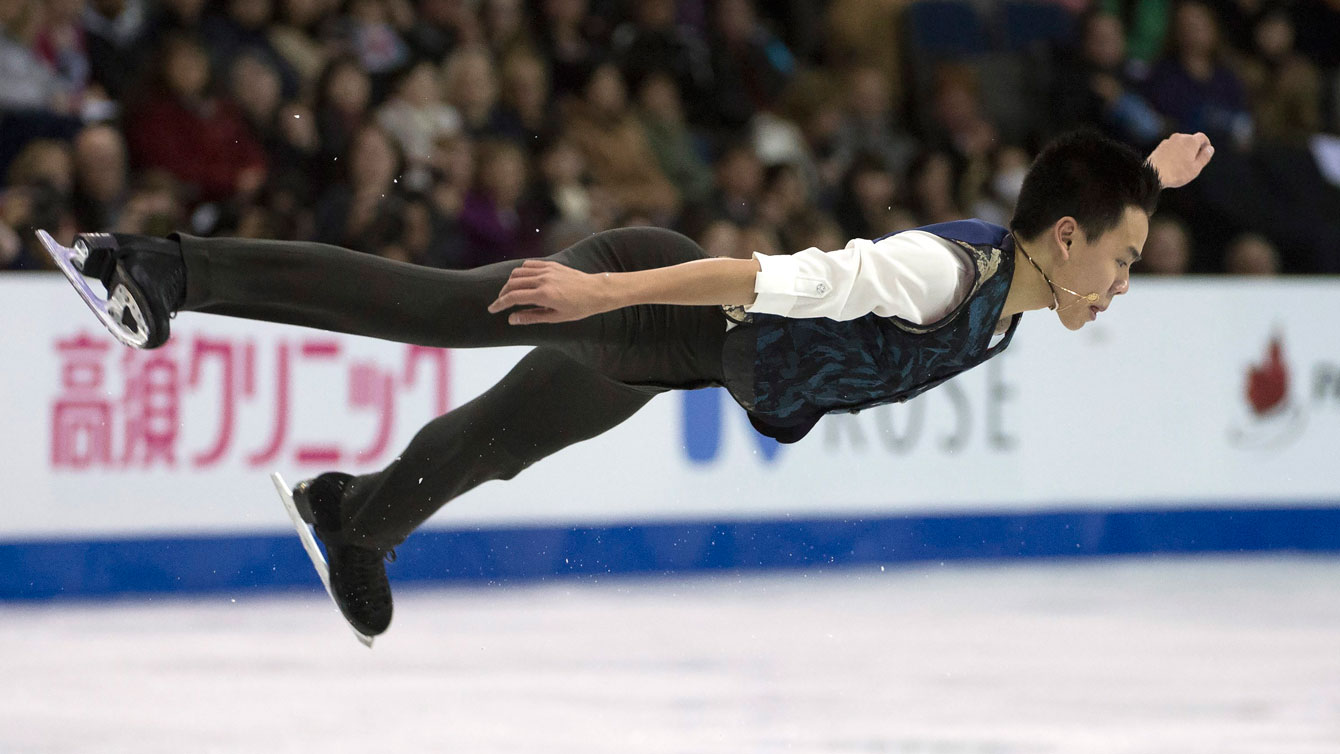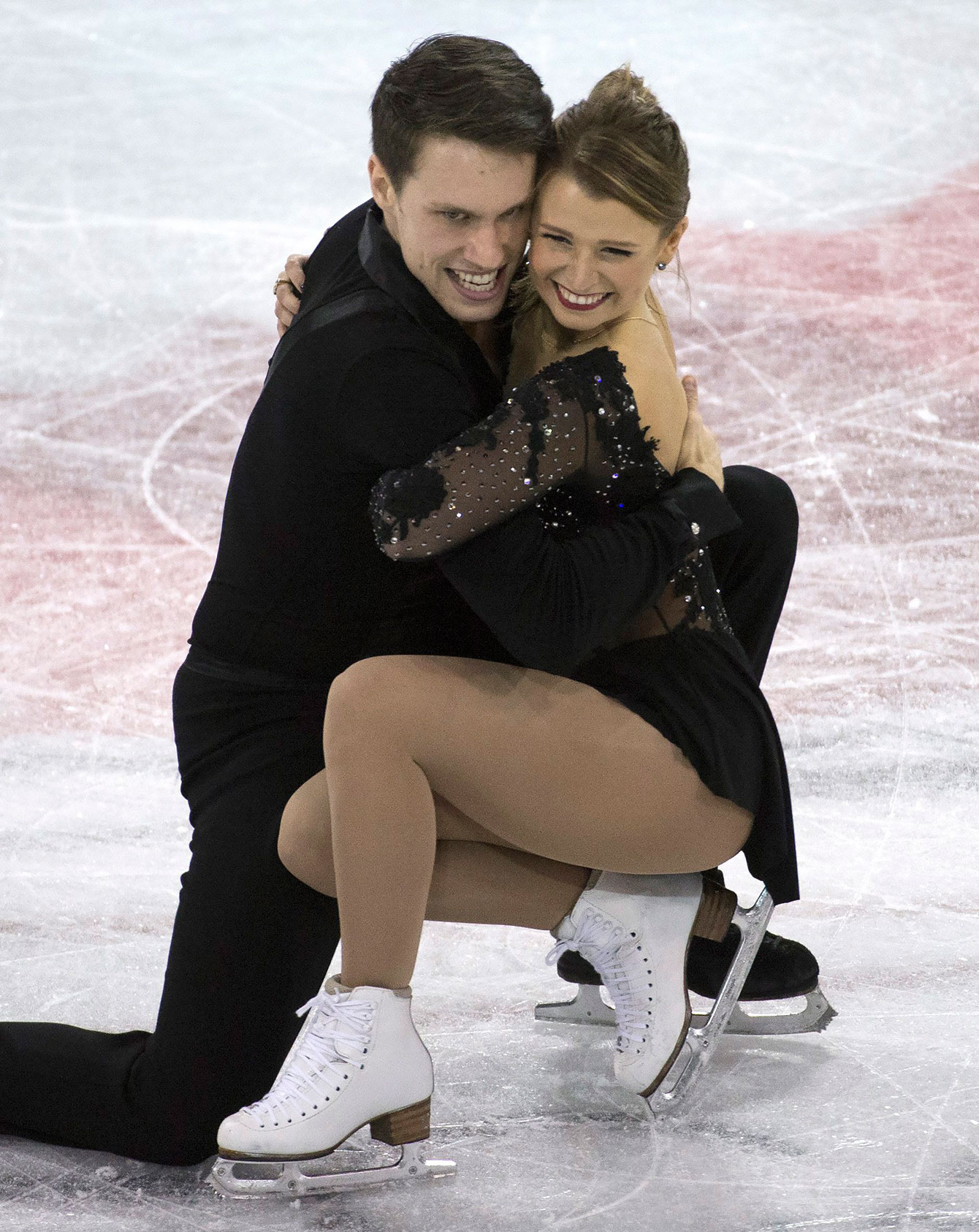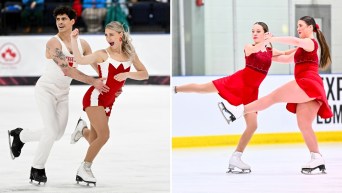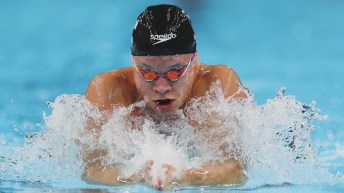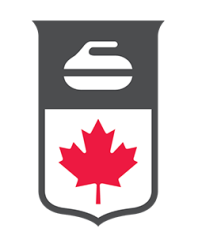Triple gold for Canadians on home ice at Skate Canada International
Canadian figure skaters at Skate Canada International in Lethbridge, Alberta delivered four medals – three gold – at the Grand Prix event that marks the real start to their seasons.
Patrick Chan‘s return to competition saw a massive gold for Canada over Olympic champion Yuzuru Hanyu of Japan; reigning world champions Meagan Duhamel and Eric Radford delivered a dominant pairs gold while Kirsten Moore-Towers and Michael Marinaro took the bronze medal; and in ice dance, Kaitlyn Weaver and Andrew Poje also claimed first place.
Saturday – Free Skates
(Scroll down for Friday’s short program recap)
Men
Patrick Chan got the moment he was looking for in his return to competition.
Near flawless technically, brilliant artistically, and just the way we remembered him, he scored 190.33 with a free skate that included eight triples and one quad to take the gold medal at Skate Canada International with an overall score of 271.14.
Olympic champion Yuzuru Hanyu had laid down the gauntlet to open the final flight, landing three quads and two triple Axels, to rebound from a disastrous short program that had left him in sixth place. But Chan not only held onto the lead he had, he opened it to 11.6 points with his outstanding performance. Yes, he tripled one of his planned quads, but the speed and flow on the landing of his jumps led to incredible grades of execution from the judging panel. He went from a technical base value of 76.92 to a whopping 95.17, which left him just 3.18 behind Hanyu in the technical elements score.
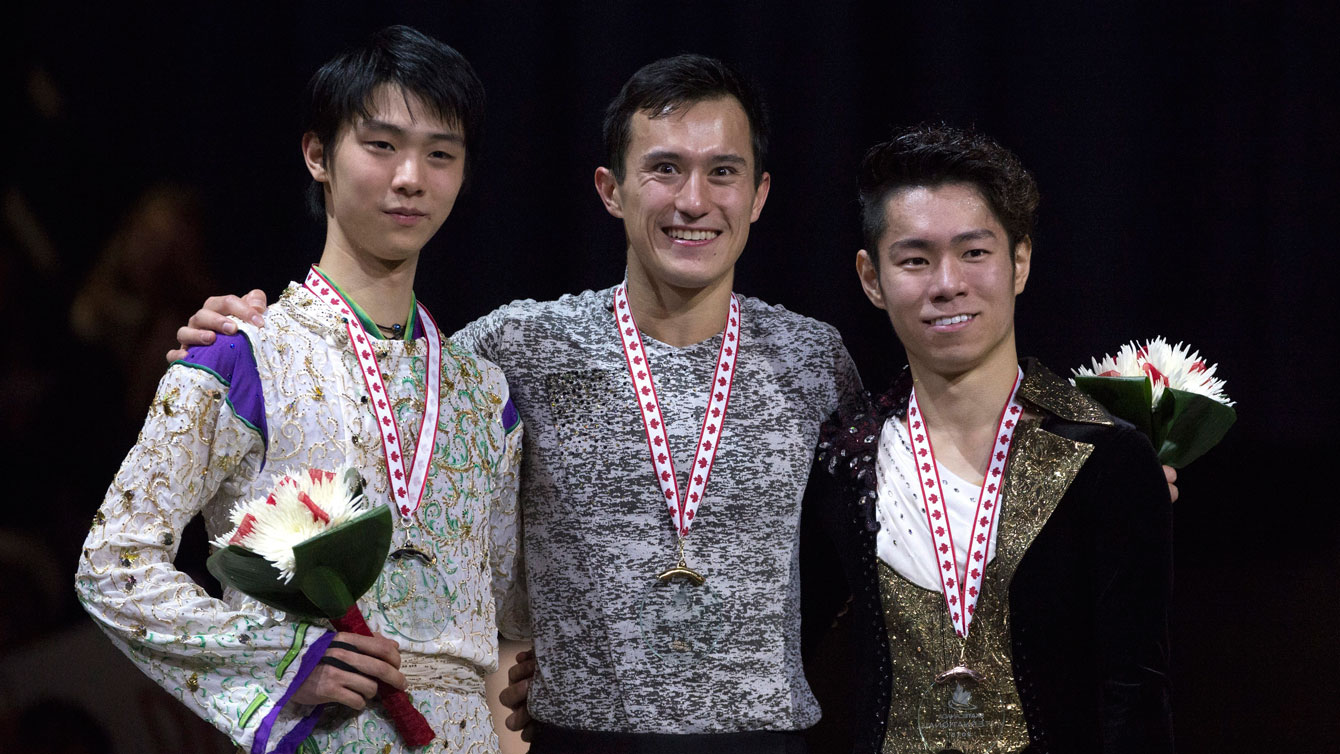
Patrick Chan (centre) receives his medal for winning Skate Canada International on October 31, 2015.
However it was in the components, the marks that take into account such things as skating skills, transitions, and choreography where Chan really cleaned up. The averages for all five component marks were in the mid-9s and there were eight individual judges marks of 10. Chan scored 95.16 for his components to Hanyu’s 88.94.
But as calm and collected as he looked on the ice, Chan admitted that he was anything but prior to the start of his program.
“I didn’t feel good on the six minute warmup, felt quite uneasy, distracted, more in my thoughts than physically,” said Chan. “This is when a relationship between a coach and a skater really goes a long way. I could really just talk about what was going through my mind, how to proceed, because I really was lost and didn’t know where to start and was really scared to go out and skate.”
“We talked it through and I stepped on the ice and really skated with no thought of who was around, who’s watching, just really skating because it feels good to skate for myself.”
With the crowd on its feet well before his music finished, the roars continued as his scores were announced, making for a tough situation for the final skater of the night, short program leader Daisuke Murakami of Japan.
“Before I went into my free program, as Patrick’s scores came up I literally could not hear (coach) Frank (Carroll) saying anything to me by the boards, so instead I told him ‘ok I’m going, I’m gonna go’ so I went,” said Murakami, prompting laughs from the media.
He also had a near-clean program with two quads and two triple Axels to win the bronze medal with a total score of 252.25.
Current Canadian champion Nam Nguyen was spectacular in his own right, placing fourth in the free skate and fifth overall. He also put out two quads and two triple Axels in a program showing great maturity and growth for the 17-year-old.
Pairs
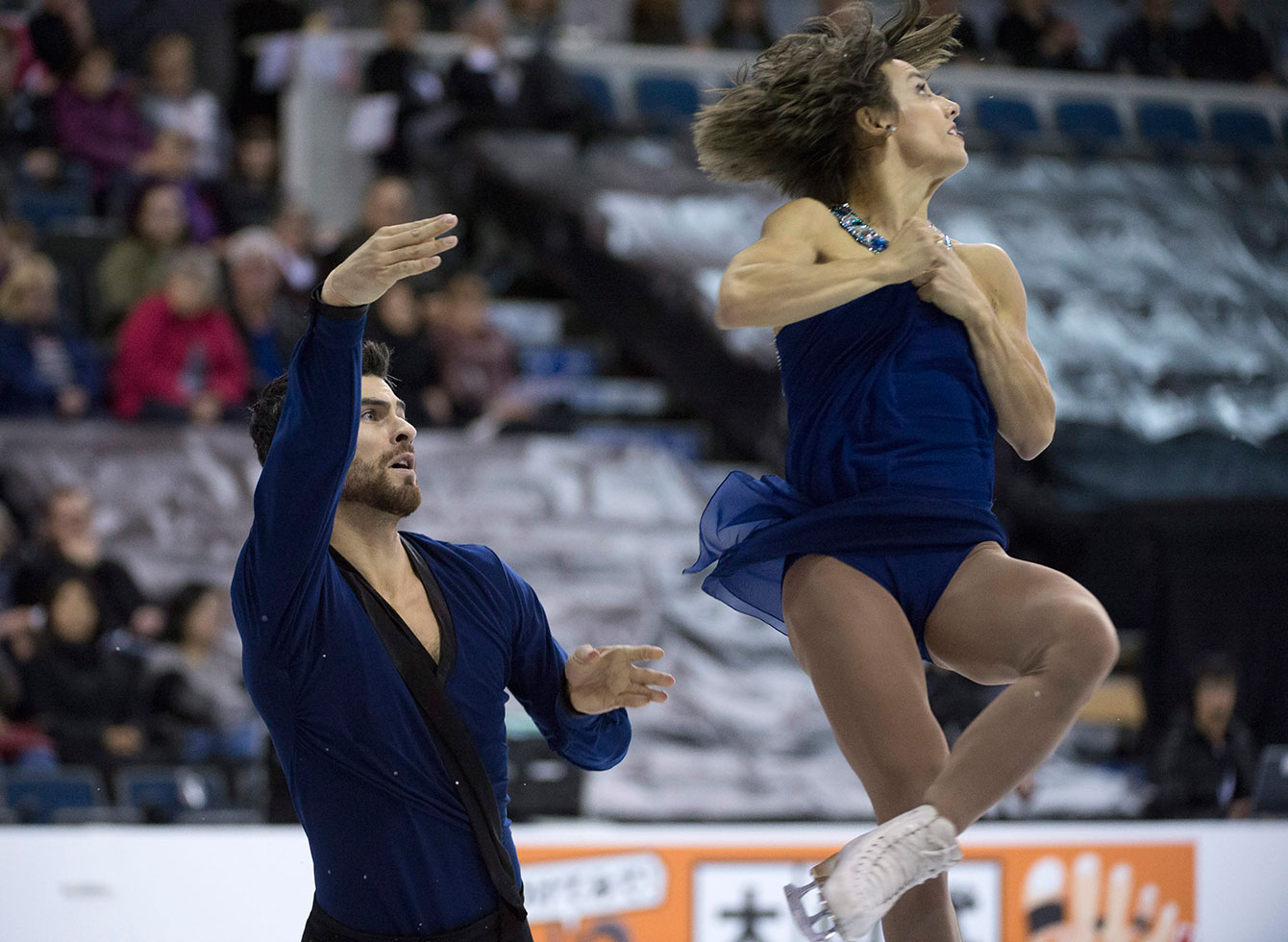
Meagan Duhamel and Eric Radford complete a throw during their pairs free program at Skate Canada International on October 31, 2015.
Neither team was perfect, but both were extremely proud of how they handled themselves in their free skates as Meagan Duhamel and Eric Radford captured their second straight Skate Canada International title while Kirsten Moore-Towers and Michael Marinaro won bronze.
For the reigning world champions, there were unusual nerves at play as they stepped onto the ice.
“We both just came in and I think we didn’t really speak to each other as much as we normally do, but whenever we did we were both feeling the same thing. A little out of our bodies, a little not as centered as we normally are,” said Radford. “I think we literally brought it all together while we were skating. We were literally making it happen in this program versus sometimes we let it happen and it happens perfectly.”
What they made happen included a throw quad Salchow that earned them +2 grades of execution from several judges, a first for them. There may be no other skaters in the world who know their numbers as well as these two. They were also happy to see their reverse lift receive an impressive nine points. It was all part of the 143.70 they earned in the free skate for an overall total of 216.16, taking first place over Russians Evgenia Tarasova and Vladimir Morozov by almost 25 points.
“I think maybe we say we don’t feel that much pressure because we’re world champions but I think we do feel it because we know what we’re capable of and we want to perform to our best ability.” – Meagan Duhamel
They chose not to include the second quad throw they’ve been training, the Lutz, hoping instead to have the type of performance that they did for the hundreds of fans waving Canadian flags.
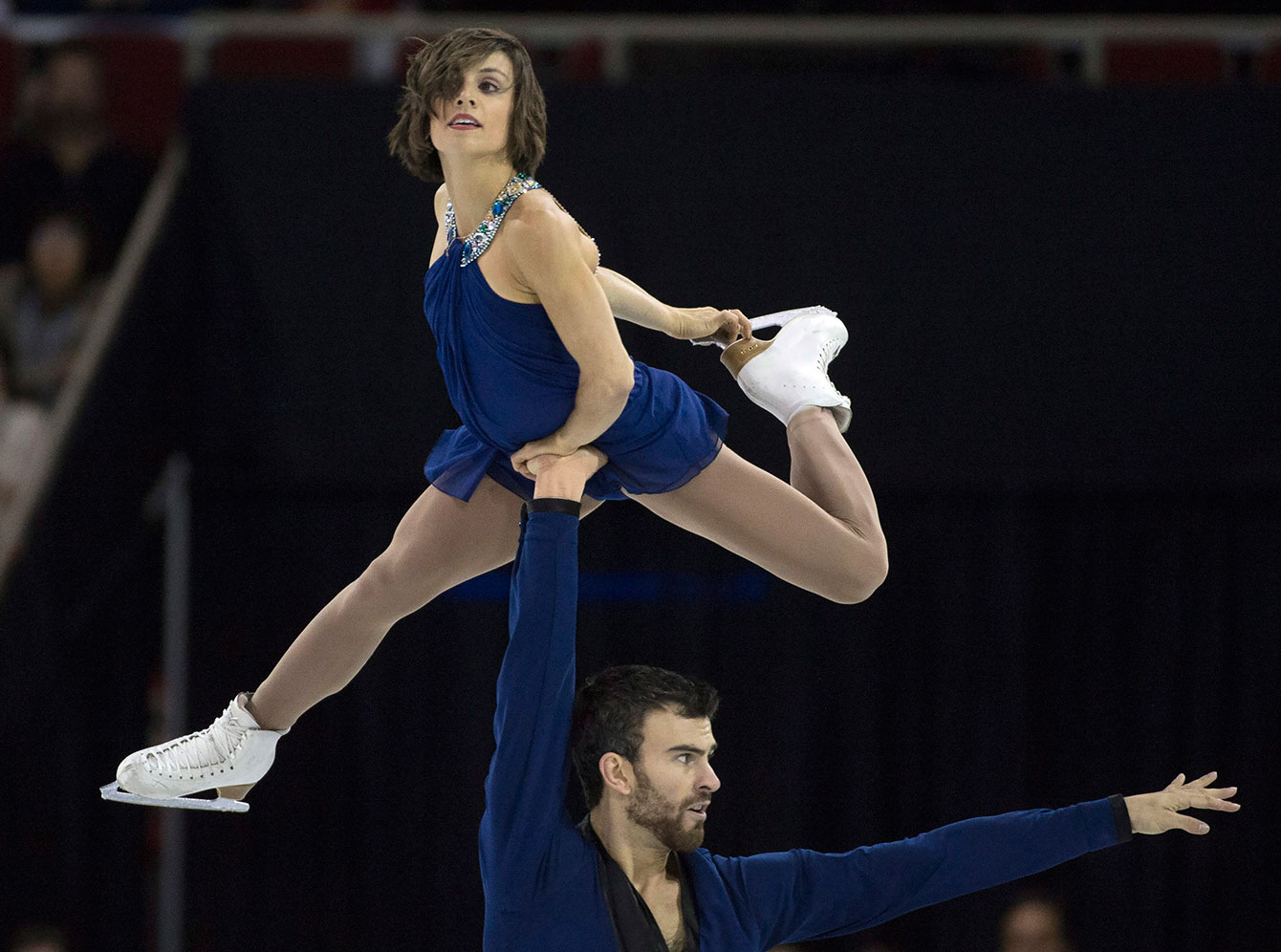
Meagan Duhamel and Eric Radford during their pairs free program at Skate Canada International on October 31, 2015.
“When we were waiting backstage I was imagining anything, what if we fall on a crosscut, what if I do a single Lutz, what if I do a single throw Salchow?” said Duhamel. “Sometimes your mind can wander anywhere and this was one of those days. We really didn’t know what to expect but I feel really proud. There are few moments in our skating career that I think I finished a program feeling as proud as I did today.”
For Moore-Towers and Marinaro, the bronze is a breakthrough – their first Grand Prix medal together. They had one major miss when a lift didn’t even take off, giving them zero points for the element. Blaming a return to old habits, they noted that they rushed a little after their successful opening three elements and tried to muscle the lift up instead of relying on the timing that new coach Bruno Marcotte has been working on with them.
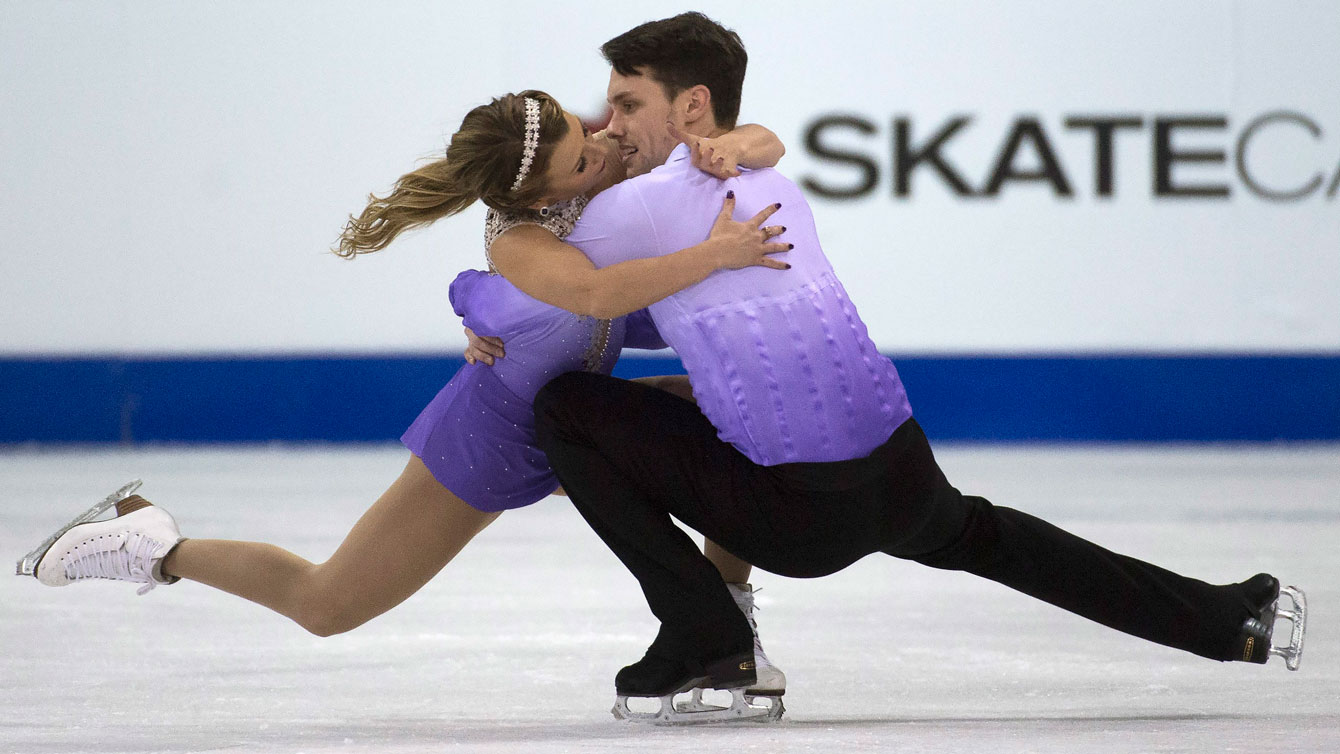
Kirsten Moore-Towers and Michael Marinaro during their pairs free program at Skate Canada International on October 31, 2015.
“After that we had a few words to each other as we skated down the ice,” said Marinaro.
“You can see me say ‘calm down’”, interjected Moore-Towers.
“And then we finished strong after that which is something we’ve been working on, recovering after a mistake so we were successful in that today,” continued Marinaro.
Their overall score of 174.85 edged out American training mates Marissa Castelli and Mervin Tran by 1.45 points.
Ice Dance
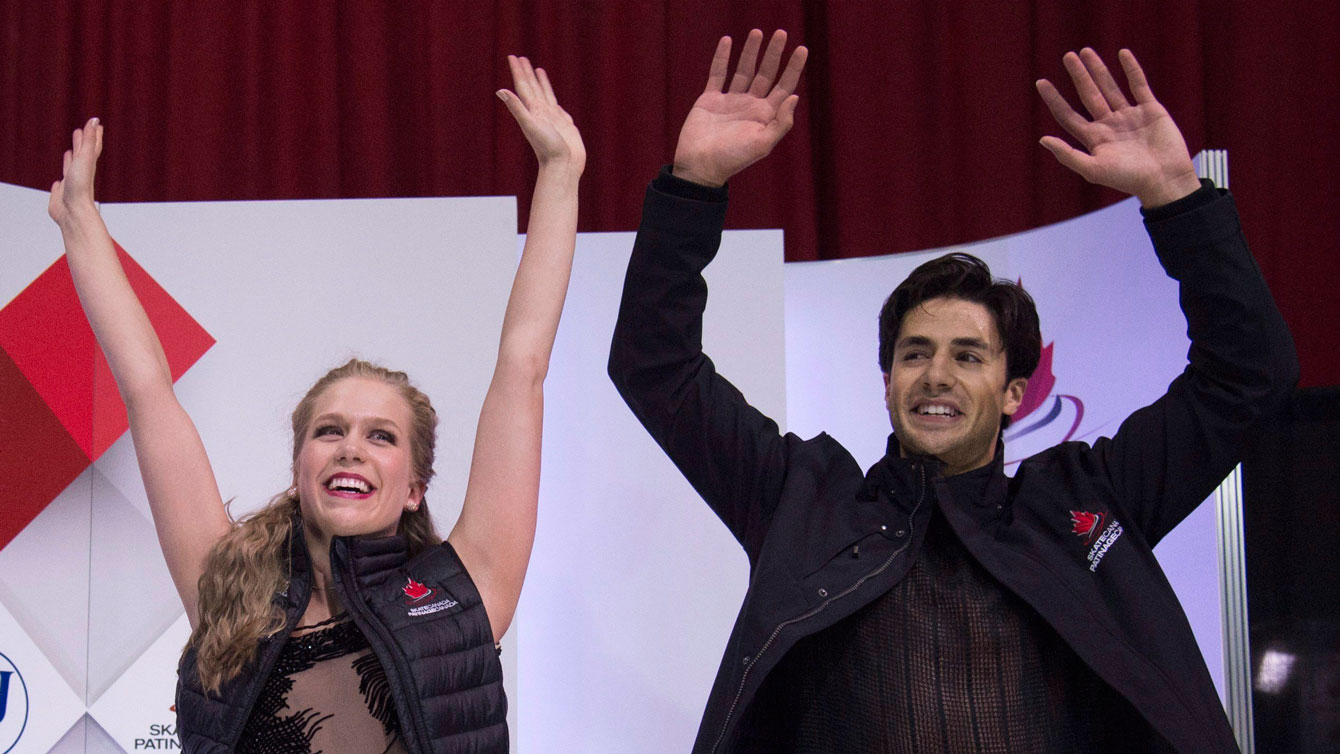
Kaitlyn Weaver and Andrew Poje celebrate as their final scores are announced at Skate Canada International on October 31, 2015.
Make it two in a row. Kaitlyn Weaver and Andrew Poje have repeated as Skate Canada International ice dance champions.
The two-time world medallists posted a season’s best score of 105.79 in the free dance to take the gold medal with an overall total of 173.79, defeating American siblings Maia and Alex Shibutani (168.36) and Russians Ekaterina Bobrova and Dmitri Soloviev (161.11), both teams also former world bronze medallists.
Weaver and Poje earned level four on four elements (twizzles, straight line lift, spin, curve lift) to go with level threes on both step sequences as well as the rotational lift. It was a drastic improvement from Finlandia Trophy earlier in October where their winning free dance score was just 96.54 for an overall total of 161.67.
“We feel like we still have an axe to grind. We want to come home with a gold medal from worlds. Period.” – Kaitlyn Weaver
They were especially pleased with their performance because they had spent very little time on the program after returning home from Finland, focusing instead on completely changing their short dance for the first week (“morning, noon, and night”) before making minor alterations to the free dance.
“It was a very intense two weeks and we stayed very present working on it but I think we both felt the weight come off after that free dance, I think moreso than we thought was there,” said Weaver. “It was a lot and now we feel like a huge sigh of relief that we’re on the right track for both programs and we can just train really hard now.”
With two victories under their belts this season, they are on a similar path to last season which saw them win every event they entered before finishing third at the world championships. That drop from the top step of the podium provided them plenty of motivation heading into their 10th season together.
“We know that we deserve to be at the top so we want to push ourselves to prove to everyone but mostly ourselves that we can be better than everyone else, better versions of what we think we can be,” said Poje.
“It was a hard pill to swallow, to be honest, to be winning everything and then not all of a sudden,” added Weaver. “And we watched our videos and thought ‘we can do better than this’. Just because we came home with a gold medal from almost every event doesn’t mean that we reached the top of our potential.”
Next up for the duo will be Rostelecom Cup in Moscow in just over two weeks.
Sochi 2014 Olympians Alexandra Paul and Mitchell Islam were sixth after three of their elements were graded at level two. Montreal training mates Elisabeth Paradis and Francois-Xavier Ouellette finished eighth.
Ladies
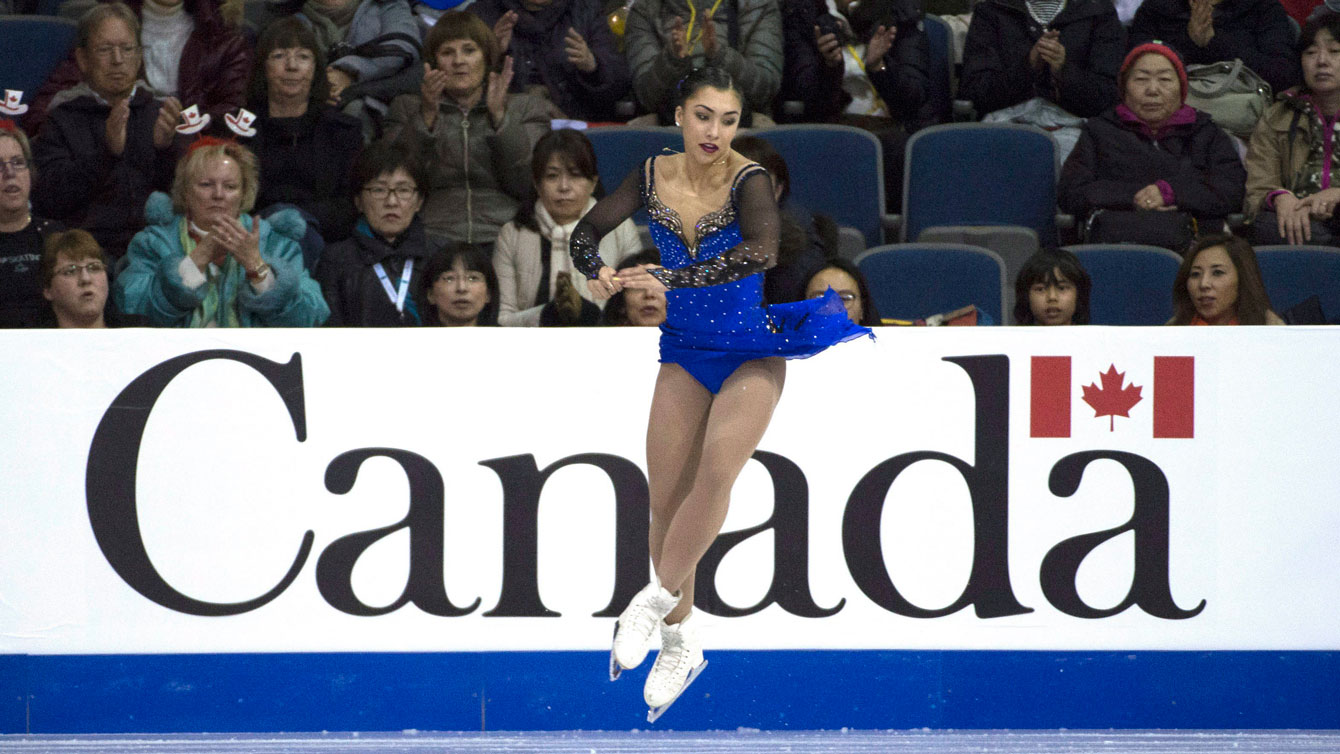
Gabrielle Daleman during her free skate in Lethbridge, Alberta at Skate Canada International on October 31, 2015.
It was a tale of two tangos for the Canadian ladies on Saturday.
Riding a high was Gabby Daleman, who placed third in the free skate to move up to fifth overall. At the opposite end of the spectrum was Kaetlyn Osmond who fell five times to drop from fourth place to 11th.
Daleman found her motivation following the passing of her biggest fan, the woman she called Nonna, about a week ago. After opening strong with her big ticket items (triple Lutz combo, triple toe-triple toe combo, triple flip), she wasn’t going to let anything get in the way of a near perfect performance of Nonna’s favourite long program.
“I was a little tired going into the loop and the sal (at the end) and as soon as I landed the loop I looked and said ‘You’re not falling on the sal, you’re doing a clean program not only for Nonna but for yourself, your coaches, Canada. You worked hard for this, you’re going to show that’ so I’m so proud of that,” said an ecstatic Daleman.
This was her Skate Canada International debut and she soaked up the standing ovation she was given by the home crowd. It was that great Lethbridge crowd that also encouraged Osmond through one of her toughest programs.
“Physically I’ve felt better,” said Osmond, who slightly injured her ankle in practice on Thursday. “It’s been a hard week in training and yesterday in competition. I’ve been doing lots and lots and lots of treatment while I was here so I’m sure in my subconscious it was probably playing in the back of my mind during the whole program.”
Osmond said she shocked herself when she couldn’t stick the landing on her normally solid opening triple flip and the follow-up double Axel. It was a domino effect from there.
“I think I just got too wound up and too excited to try to keep pushing forward and getting everything done that I started muscling all the jumps and not just letting them happen. It just wasn’t my day apparently.”
Next up for Daleman will be a trip to France for Trophee Eric Bompard in a week and a half, while Osmond has just over three weeks to regroup before NHK Trophy in Japan.
American Ashley Wagner took the gold medal ahead of reigning world champion Elizaveta Tuktamysheva of Russia and Grand Prix rookie Yuka Nagai of Japan. The third Canadian, Veronik Mallet, finished 10th.
Friday – Short Programs
Men
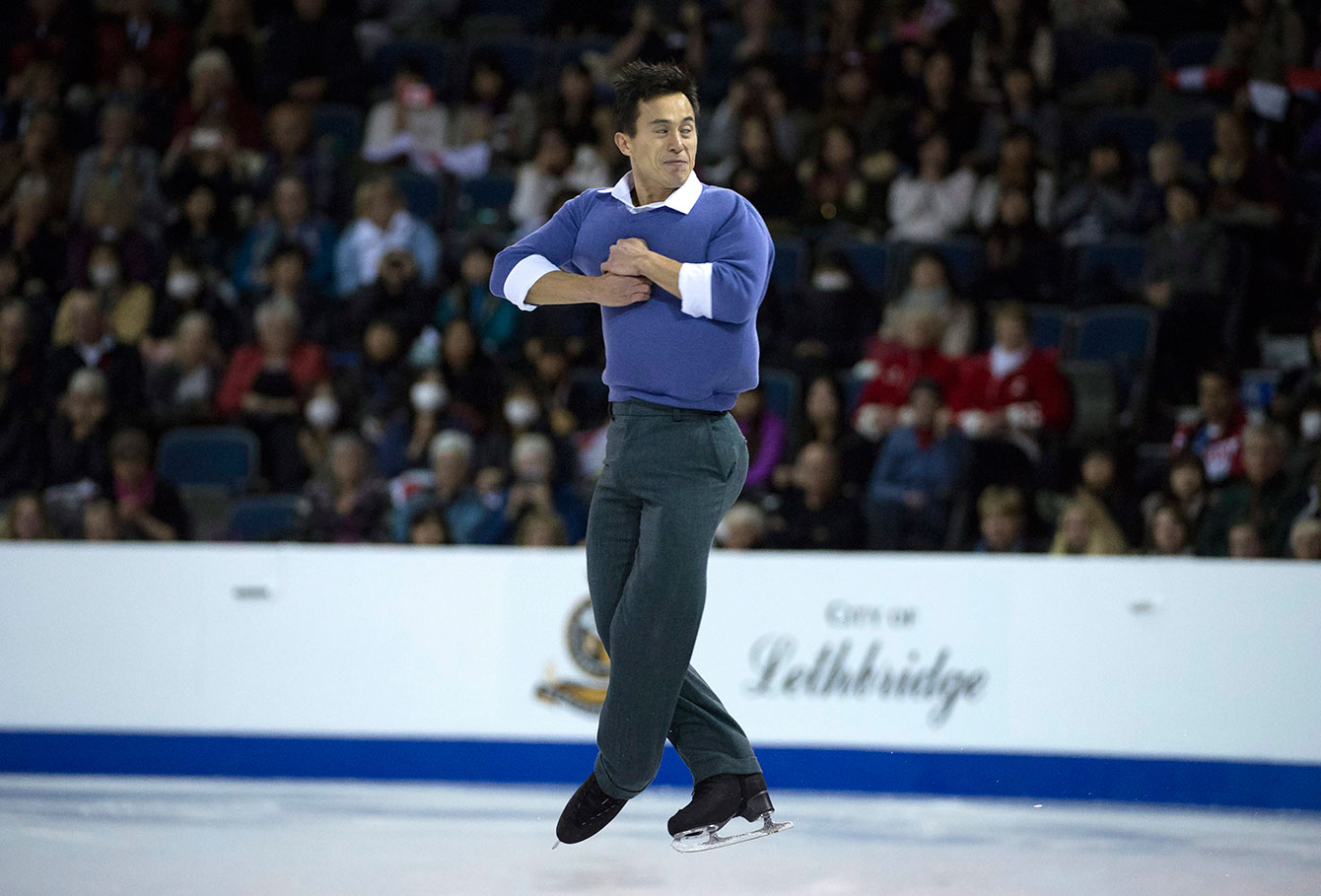
Patrick Chan performs an element during his short program at Skate Canada International in Lethbridge, Alberta on October 30, 2015.
If anyone could have seen how the men’s short program would play out, they must have a crystal ball and psychic abilities because it was truly unpredictable.
In his return to Grand Prix competition, Patrick Chan sits in second place, but in a virtual tie with leader Daisuke Murakami of Japan, separated by a mere 0.07 of a point (80.88 to 80.81). It’s almost as tight to third place finisher American Adam Rippon who’s just 0.45 back of Chan. Reigning Canadian champion Nam Nguyen is fourth with his 76.10 points.
Chan started strongly, with an outstanding quad toe, but the triple toe he tacked on for the combo had a slight bobble on the landing. That minor disturbance had a major effect in a program with as many transitions and character moments as the one Chan is attempting to “Mack the Knife”.
“Usually I need a lot of momentum and flow into my Axel so I’m not pushing into the Axel. That’s been a huge part of getting it more consistent is having good flow and not having to feel like I’m going too slow into the jump,” said Chan. “That’s the price you pay when you walk the fine line between the program that can be so much but when you can’t get everything right on point the mistakes become quite large.”
After he fell on the triple Axel, he doubled a planned triple Lutz which gave him zero points for the element.
But he was still able to smile and laugh throughout his time with the media as he relished being back on competitive ice.
“Luckily I didn’t feel like I was dreading this first program. I was off the ice waiting for my turn, felt excited, calm, in control and I think that’s why the quad was successful,” he said. “The biggest part of the frustration I have right now is that I can go out and have lights-out practice (as he did Friday morning)… I know I can have many great moments. It’s just figuring out how to do it again and again.”
Chan had skated in the first flight because of his low world ranking. He then watched as Nguyen got his quad combo in but also fell on his Axel. It was up to Olympic champion Yuzuru Hanyu to close the men’s event. He got caught by a rule that led to him receiving no marks for a planned quad toe that turned into a double and zero for his triple Lutz combo when the planned triple toe turned into a double. Skaters are not allowed to repeat jumps in a short program. He is in sixth place with 73.25 points.
Pairs
Following the inconsistent performances in the ladies’ and men’s events, the crowd in Lethbridge was just waiting to jump to their feet and the Canadian pairs gave them that chance.
First came Kirsten Moore-Towers and Michael Marinaro. In their second season together they moved to Montreal from Waterloo, Ontario (“Across the country” said Marinaro. “We moved one province,” cut in Moore-Towers) and are already proving it was the right decision.
Skating to Etta James’ “If I Can’t Have You” they were more expressive with each other than ever. And with every successful element, the crowd got louder and louder, especially on their side by side triple toes and throw triple loop, culminating in their first standing ovation as a team.
“It was just how I planned it of course,” said Moore-Towers. “I think that it takes up to a couple years to figure out who you are as a team so that’s what we’re trying to do but in a direction that’s different from what we’ve done before.”
That cheering didn’t throw them off as they scored 63.17 to sit in third place.
“Our training mates in Montreal, nobody does a run through without some cheering so it’s something we’re used to and it helps carry us through the program,” said Marinaro.
Included in that large contingent of training mates here are reigning world champions Meagan Duhamel and Eric Radford, who wanted to get right on the ice to build on the momentum. But they had to wait to skate last on the night.
It wasn’t their best performance; Radford put a hand down on the side by side triple Lutzes and they had to fight through some of the other elements, including the throw triple Lutz. But thanks to their training they were able to push through and take an 8.46 point lead (scoring 72.46) into the free skate as well as a few other positives.
“We got our very first level four triple twist,” said Duhamel. “That was a big goal for us this year. We just added the steps a couple weeks ago to try and see if we could get it.”
“This was also the first time we were able to hit our proper ending position,” added Radford. “Usually we always say ‘take our time’ and then we end up taking our time a little too much and I have a signal to Meagan at the very last lift I say ‘stop’.”
“And I was waiting for him to yell stop at me,” exclaimed Duhamel.
With the crowd on their feet before they finished their performance to “Your Song”, the duo is also hoping for one famous face to take note of their free skate on Saturday after having recently had the opportunity to perform with Ginette Reno singing live the song they used for last year’s short program.
“We’re hoping that maybe it’ll follow suit and we’ll get to skate live to Adele,” said Radford.
“I don’t know how involved she is but maybe she can catch wind of our long program, that would be so cool,” added Duhamel.
Hello? Adele? It’s your move.
Ice Dance
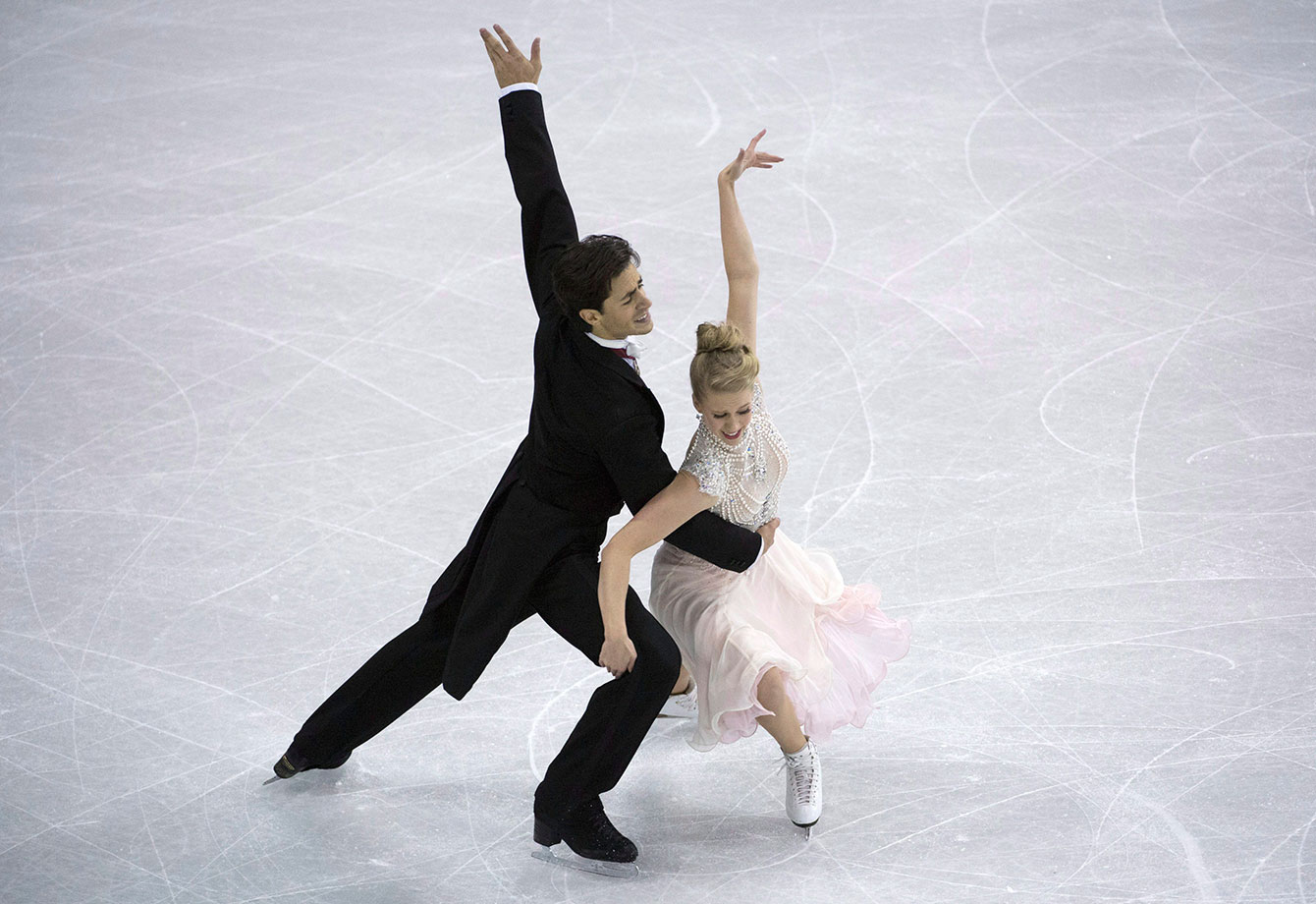
Kaitlyn Weaver and Andrew Poje during their short program on October 30, 2015 at Skate Canada International.
When the ISU designates the short dance rhythms for the season, a sometimes lengthy choreographic process begins. Skaters want to find that perfect and hopefully unique piece (or pieces) of music that will take them to their goals. So what happens when you put a program out in competition that doesn’t get rewarded the way you thought it would? Well, if you’re Kaitlyn Weaver and Andrew Poje, you scrap what you spent months creating and start fresh.
Despite a win earlier in October at Finlandia Trophy, their Elvis Presley themed dance was not well received by the judges. They knew immediately that a change had to be made to make the required rhythms much clearer. So with no time to waste, they turned to waltz master Strauss.
“The day we got back we had a meeting in the morning, picked out music that afternoon and was on the ice ’til midnight that day making up a new program,” said Poje. “It was a very quick turnaround but it was something we needed to do to make sure we felt comfortable out there today.”
And boy did they, scoring 68.00 to lead by two points over American siblings Maia and Alex Shibutani.
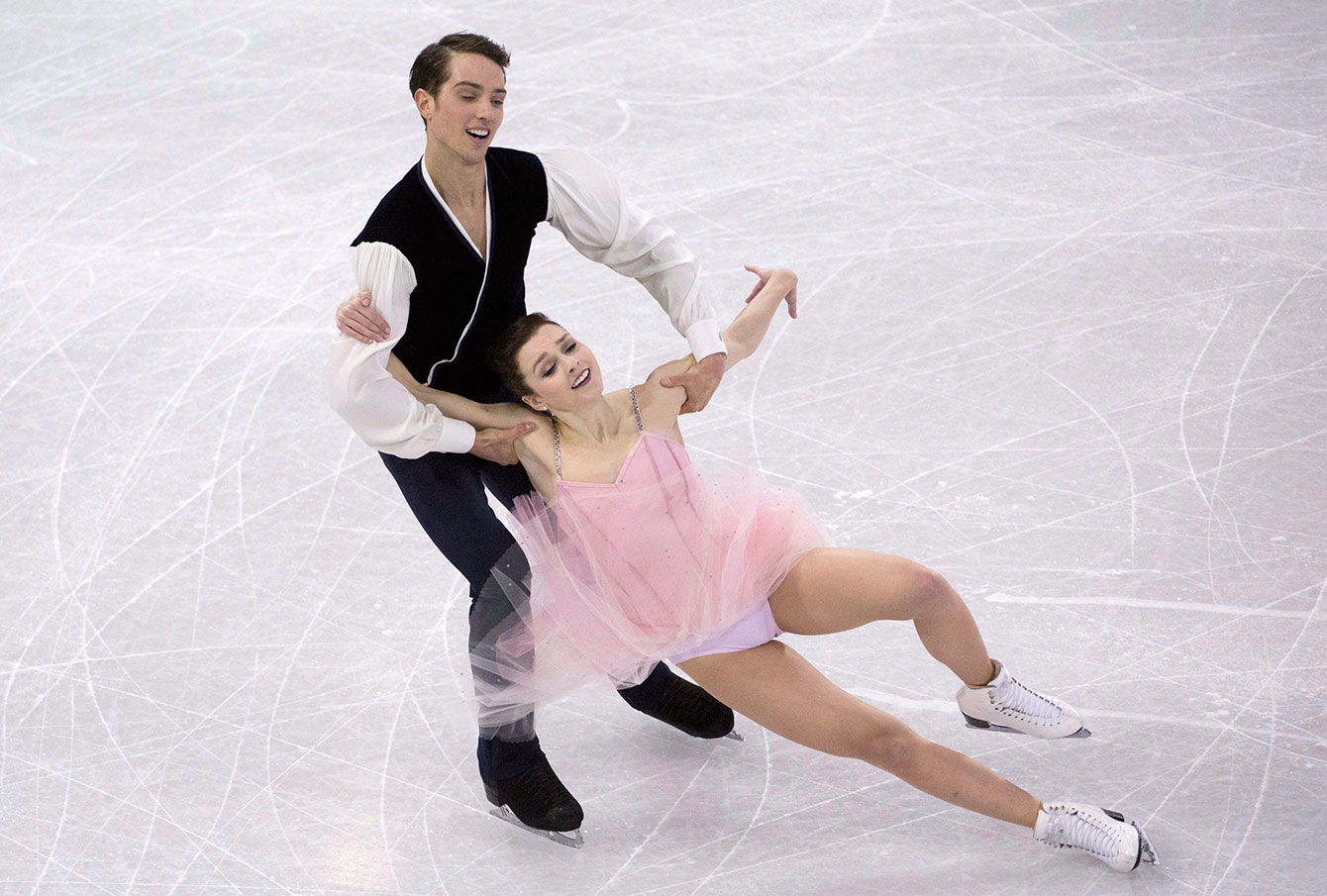
Alexandra Paul and Mitchell Islam in their short program on October 30, 2015 at Skate Canada International.
“I think that when we took the ice today we even forgot that it was brand new,” said Weaver of the two-week old program. “We felt comfortable and sometimes you have to convince yourself that it isn’t brand new. But we love this program and we’re so happy that in its debut it was received so well by the audience and I think there’s no better way to start than how we just did.”
The two-time world medallists also recognize there is room for improvement. They earned just one level four on their opening lift. All of their other elements, including the required Ravensburger Waltz sequences as well as the twizzles, were scored at level three.
“It’s very early in the season still but we feel stronger with this,” said Poje. “With this new program I feel it lets us bring out the strengths of the key points (of the Ravensburger Waltz) so we can really capitalize on that. We’re happy that the audience and the judges liked the program and we’re going to get better as the season goes along.”
“It’s extreme to get a new program and it’s extreme to go from Elvis Presley to Strauss,” added Weaver. “We were sad a little bit to say goodbye to Elvis but we know it will come back in another year in another form but we really love this program and I think we’ve gotten the nod now that this is the right direction and the right way to really tribute these rhythms.”
Fellow Olympians Alexandra Paul and Mitchell Islam are sitting in fifth place with a score of 57.55 while their Montreal training mates Elisabeth Paradis and Francois-Xavier Ouellette are eighth with 47.77 points.
Ladies
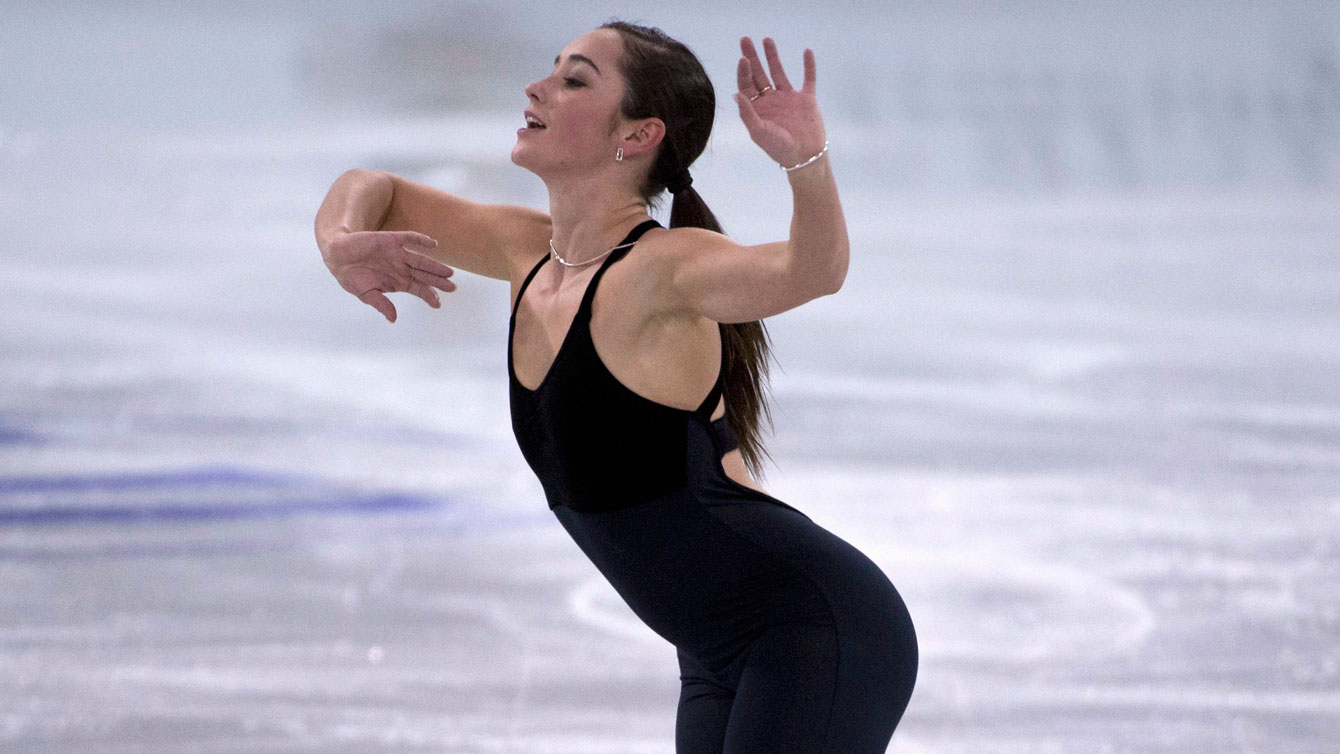
Kaetlyn Osmond during practice prior to Skate Canada International at Lethbridge, Alberta on October 29, 2015.
In her first Grand Prix event since winning Skate Canada in 2012, two-time Canadian champion Kaetlyn Osmond finds herself in fourth place, something she probably couldn’t have imagined after she was first on the ice for the ladies’ short programs.
Osmond started brilliantly, landing a triple flip-triple toe combo and a triple Lutz, the first time she’s done those elements together successfully this season.
“It made me fly,” she noted afterwards.
But that adrenaline rush might also be to blame for the awkward fall she took on the entry to her flying camel spin.
“Falling in complete middle splits isn’t the most amusing thing to do,” said Osmond, who maintained her sense of humour and positive attitude. “I think it was more of a shock than anything the way I fell and then I couldn’t fully get myself back on top of my feet before the Axel, which is something I should probably learn how to do if that happens again.”
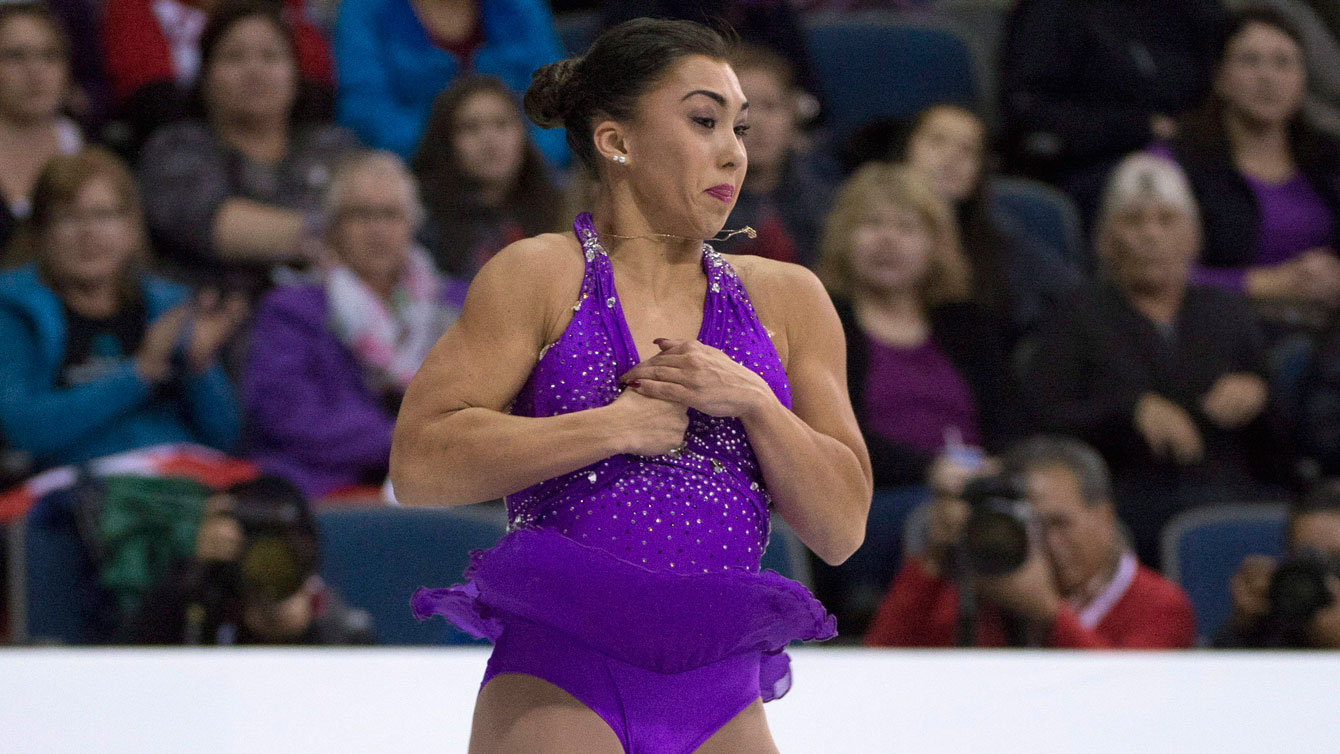
Gabrielle Daleman performs a jump during her short program at Skate Canada International on October 30, 2015 in Lethbridge, Alberta.
Osmond received no marks at all for the missed spin, an element that earned her 3.70 points in her win at Nebelhorn Trophy and which she considers her best and favourite spin. Taking into account the follow up fall on the double Axel, she could have scored in the upper 60s instead of the 59.21 she did earn, putting her just 0.58 behind third place finisher Kanako Murakami of Japan. American Ashley Wagner leads with a personal best 70.73 points for her outstanding “Hip Hip Chin Chin” Latin dance-inspired program in which she said she tried to do her best Tessa Virtue impression.
Osmond’s technical score was still the third highest of the day and held up after numerous errors from the rest of the field, including reigning world champion Elizaveta Tuktamysheva of Russia who is in seventh place, just ahead of Canadians Gabrielle Daleman and Veronik Mallet.
“I feel amazing,” Osmond added. “I was so excited with even the program I did. Yes I had two falls but they’re two things that I never miss. I know that today was just probably over-excitement of being back on the ice, being back in Canada competing.”
After missing all of last season due to a broken ankle that required two surgeries to insert and then remove hardware, Osmond gave herself a scare in practice on Thursday when she rolled her other ankle on a jump takeoff.
“It was just a fluke accident, pretty much a fluke accident like the one in my program today,” she said. “I’ve gotten like five physio treatments in the last two days so it’s actually feeling pretty good. It hurts but it’s tolerable.”

